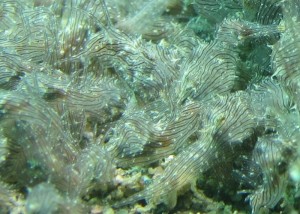Loading content - please wait...
Sea Hare Mating in Gorontalo
That tumbling mass is really sea hare mating! Imagine the surprise of divers looking for critters at Sand Castle, one of Gorontalo’s muck diving sites. On the sand in shallow water were masses that looked like sea weeds, rocking back and forth in the gentle surge. In fact, there were patches of algae on the sea floor. That added to the confusion. But a closer inspection revealed a rarely witnessed event, sea hare mating.
Slugs Looking Like Rabbits
Sea hares are members an opisthobranch order of sea slugs. More colorful opisthobranchs are famously called nudibranchs. Their sensing organs are called rhinophores. In sea hares, these and their oral tentacles are rolled. Many sea hare species have an internal shell, giving them a pudgy appearance. These characteristics make the slug look like a rabbit, hence the name. Sea hares can grow to enormous sizes and weigh five kilograms or more.
Lined Sea Hares
The sea slugs discovered by guests of Miguel’s Diving in the midst of sea hare mating were not of the large variety. Instead, they were Lined Sea Hares (Stylocheilus striatus).

Notice the fine dark lines in the photo by Senior Aldo Galante of Buenos Aires. Some light spots are also visible. This color pattern makes for great camouflage. Lined Sea Hares are usually quite small, such as the ones found in Gorontalo that day. But they can grow to up to 65 mm in length. Like other sea hares, Lined ones eat blue-green algae. When disturbed, most sea hares will secret purple ink. This purple secretion actually comes from toxins found in the blue-green algae eaten by sea hares.
Sea Hare Mating Video
To witness sea hare mating is a rare event. Watch the video shot in Gorontalo that day.
At the beginning of the video
, there are several still photos. Can you make out the individual sea hares? Notice how the mass of sea hares resembles the clump of algae growing on a nearby rock. Do you see individual sea hares crawling from the upper left screen towards the sea hare mating frenzy? Notice the dark portion inside the body of a sea hare. This is the internal shell.
For your chance to witness a rare marine event, please make a dive booking with us at info@miguelsdiving.com






Sorry, comments are closed for this post.